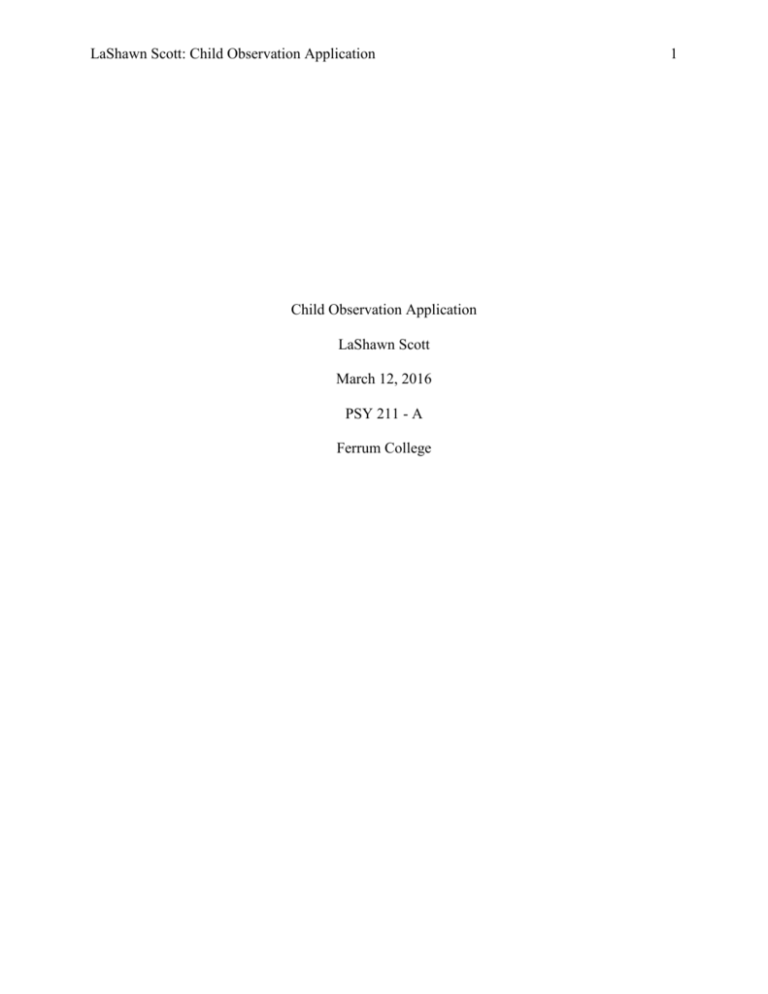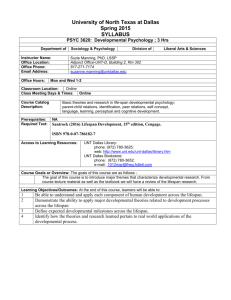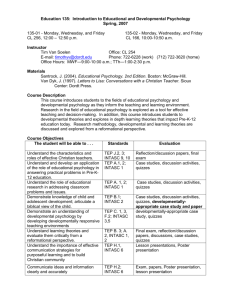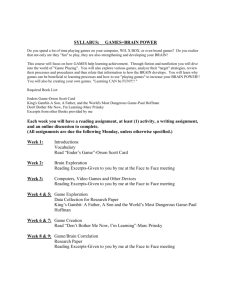Child Observation Application
advertisement

LaShawn Scott: Child Observation Application Child Observation Application LaShawn Scott March 12, 2016 PSY 211 - A Ferrum College 1 LaShawn Scott: Child Observation Application 2 Within one hour children participate in many different activities. Children 3 years of age and up enjoy simple activities such as hopping, skipping, jumping, and running back and forth, but have you ever took the time out and actually observed what the child does, how they do it, and why they do it. This project consisted of observing a child 4 years of age or younger for 60 minutes, recording everything he or she did and said within that time limit, than writing them in intervals no larger than 3 minutes. After doing this observation we are now applying everything that we learned throughout the course including concepts and theories from: motor, perception, cognitive, Language, emotional, and social development to our child observation. The child I observed show many qualities that connected to the material that we learned throughout the semester. The subject was a male three years of age in a class room setting with seven other students of his age group who happened to be female; there were also two female teachers in the room as well. The subject showed different types of motor skills including gross motor skills. Gross motor skills are motor skills that involve large activities such as moving one’s arms and walking (Santrock, 146). This type skill are shown when the subject walks around the room, this shows that the subject is what you call an experienced walker; he no longer has to make an effort. This skills is also seen when the subject moves his arms to grab toys and also seen when he runs up to the door and shuts it, he is using both his legs and arms for movement. Aside from gross motor skills the subject also shows fine motor skills. Fine motor skills are motor skills that involve more finely tuned movements, such as finger dexterity (Santrock, 152). The subject show that he has these skills by showing he has the ability to pick up a small toy with his fingers, when he plays with the blocks he hits them together trying to piece them, LaShawn Scott: Child Observation Application 3 and again when he is playing with another little boy of the same age; he takes the toys he is playing with and then tries to line the then up so the other boy can play. Another concept is that the subject did not show two well was perception development. Perception development is the interpretation of what is sensed. The subject shows signs of both hearing and sight which would be considered as intermodal perception. Intermodal perception, the ability and integrate information about two or more sensory modalities, such as vision and hearing (Santrock, 162). Cognitive Development emphasis on how children actively construct their feelings. You can see the subject process knowledge through Piaget’s theory of schemes which is actions or mental representations that organize (Santrock, 172), when the subject takes the toy he is playing with and lines them up. He is classifying the objects by shape and size. Along with Piaget’s processes of development he also identified four stages of cognitive development including: sensorimotor, preoperational, concrete operational and formal operational (Santrock, 173). Each of these stages is age based, according to this age classification the subject belongs in the preoperational stage. The preoperational stage last from two to seven years of age when the child begins to represent the world with images and drawings (Santrock, 180). Within this stage there are two substages: the symbolic function substage and the intuitive thought substage. The subject is currently in the symbolic substage. The symbolic substage is when the child gains the ability to mentally represent an object that is not presented (Santrock, 180). The subject shows this concept when he is playing with a toy truck while mumbling like he is talking with someone else. He is talking to a person or an object that is not present. LaShawn Scott: Child Observation Application 4 Language development is another concept that my subject showed. Language is a form of communication whether spoken, written, or signed. According to Ralph Waldo Emerson organization of language, this rule system involves five rules: phonology, morphology, syntax, semantics, and pragmatics (Santrock, 260). The subject falls in the syntax group. Within this group he falls in the telegraphic speech category. According to Dr. Steins 2012 notes telegraphic speech is the ability to speak but a lot of words are left out. You see this concept when the subject says, “Hey I dry her hair.” This is a complete thought but small in important word are being left out. The Subject also shows signs of language develop when he cries. The subject was pushed by one of the other children and fell on his bottom, as a result he begin to let out a pain cry. Pain cries begin with a long shriek followed by seconds of silence and then more vigorous crying (S.E.S Personal Communication, 2012). While crying he showed a sign of language when he held his arms up wanting to be picked up, this a signed form of language. Pain cry is also part of emotional development; it shows that the child is mad and upset. Emotional Development is the development of feelings, and affections that occur when people are in a state or interaction (Santrock, 290). The subject showed a sign of emotion when he smiled. The smile that he made was a social smile, a smile that occurs in response to an external stimulus typically a face. Along with that smile he showed another sign of happiness when he laughed while playing with the other children. While talking about the subject his temperament seems to be very cheerful and playful. Temperament involves individual differences in behavioral styles, emotions, and characteristic way of response (Santrock, 299). According to Chess and Thomas’ Classification of temperament, they broke it down into three groups; easy child, difficult child, and slow – to – LaShawn Scott: Child Observation Application 5 warm – up child. My subject falls in the easy child category. An easy child is generally in a positive mood, quickly establishes regular routines, and adapts easily to new experiences (Santrock, 300). You see these traits when the child is playing happily with the other children, he also shows that he knows the routines of the class room when the teacher pulls out certain toys and calls out clean up. The subject also shows that he falls in this category when he is told that they will be going to a new class room, he got in line with the other children and walked single filed into the next room where he was very content and well behaved. Another way of classifying temperament is from Mary Rothbart and John Bates. They characterize temperament into extraversion/surgency, negative affectivity, and effortful control (self-regulation). My subject fits in to the extraversion/surgency concept. He is very active, and positive. He also seeks sensation, you see this when he puts his fingers in his mouth and again when he takes the paper towel that he wipe his has with and put it in his mouth as well. When applying concepts and theories to a child observation it becomes very difficult. The child showed more characteristics in some of the stage then others, for example; when applying cognitive development to the child observation the subject started showing signs of Piaget’s preoperational stage but they were not completely developed yet. The theory that the subject displayed the most and which is also the easiest and my favorite is emotional and social development. The subject was very active and social with his classmates which apply concepts easy. The perception development was the most difficult most of the concepts and theories for this development were for infants and therefore harder to apply. Simply things such as running, jumping, skipping, and hoping or even moving your hands a certain way can be applied to many different concepts and theories. You never know what a child can learn, observe, and preform within the length of an hour. In this paper I have LaShawn Scott: Child Observation Application gone over all the concepts and theories from class and text that the child showed including: motor, perception, cognitive, Language, emotional, and social development. Although many of the concepts could not be fully explained due aging and development; you can clearly see that the child is learning and progressing at a steady rate. 6 LaShawn Scott: Child Observation Application References Santrock, John W. (2011) Child Development Thirteenth Edition. New York, NY. McGraw Hill. 7







